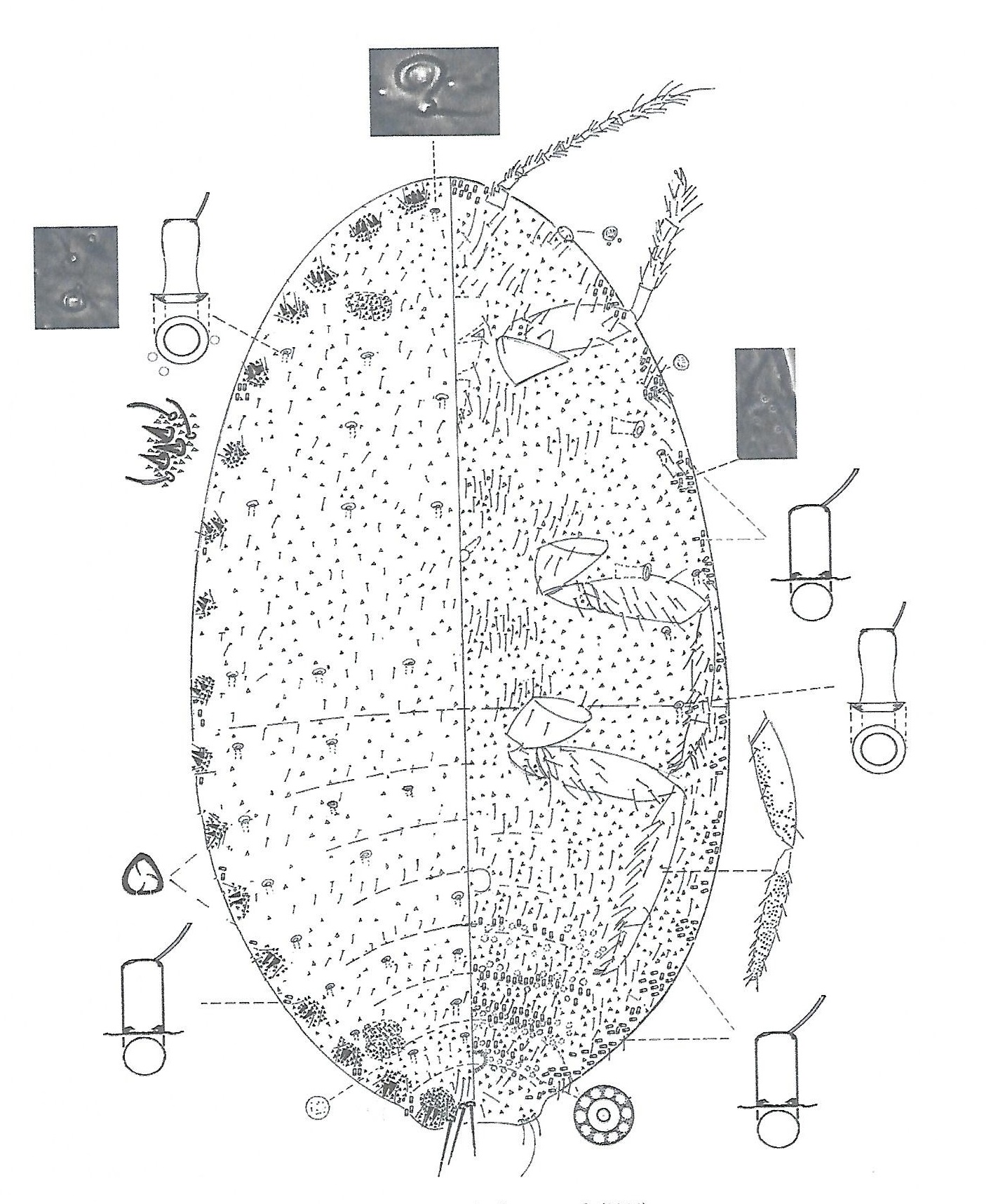Valid Names Results
Pseudococcus meridionalis Prado, 2011 (Pseudococcidae: Pseudococcus)Nomenclatural History
- Pseudococcus sp. 1 González 2003: 5-17. nomen nudum
- Pseudococcus meridionalis Prado 2011: 47-53. Type data: CHILE: La Serena, on Punica granatum, 10/5/2002, by Col., M. Zambrano. Holotype, female, by original designation Type depository: Santiago, Museo Nacional de Historia Natural de Chile, Santiago, Chile ; accepted valid name Notes: Paratypes: four adult females with same data as the holotype
- Pseudococcus rubigena Gonzalez 2011: 122-131. junior synonym Notes: In July of 2011, Roberto González and Ernesto Prado became aware that they were studying the same Chilean mealybug species. The research by González (2011) emphasized the biology, economic importance, and control of the species on fruit, and described it as the new species Pseudococcus rubigena González. The research by Prado in Correa et al. (2011) provided a detailed description using molecular and morphological data and described the new species as P. meridionalis Prado. The date of publication of the Correa et al. paper is clearly marked as June 22, 2011. In a letter dated November 23, 2011, Nelson Cannoni M., Gerente General, Impreta Italiana indicated “ULTIMO DESPACHO DE EJEMPLARES: 30 de junio de 2011.” This is considered the date of publication for the name P. rubigena which was predated by P. meridionalis by just nine days. Therefore, Pseudococcus rubigena is considered the junior synonym. Illustr.
Common Names
Ecological Associates
Hosts:
Families: 7 | Genera: 9
- Amaranthaceae
- Alternanthera pungens | GranarGo2018
- Atriplex lampa | GranarGo2018
- Asteraceae
- Conyza bonariensis | PachecKaMa2017
- Parthenium hysterophorus | GranarGo2018
- Ebenaceae
- Diospyros kaki | PachecKaMa2017
- Juglandaceae
- Juglans australis | GranarGo2018
- Lythraceae
- Punica granatum | CorreaAgGe2011
- Rosaceae
- Pyrus pyrifolia | CorreaAgGe2011
- Vitaceae
- Vitis vinifera | CorreaAgGe2011
Geographic Distribution
Countries: 3
- Argentina | GranarGo2018
- Brazil | CaballPaKa2021
- Chile | CorreaAgGe2011 | Gonzal2016
- Coquimbo | PizarrAlBa2020
- Metropolitana | CorreaLoMa2015
- O'Higgins | Gonzal2011
Keys
- GranarGo2018: pp.10-14 ( Adult (F) ) [Central & South American Pseudococcus]
- VonEllWa2016: pp.74-75 ( Adult (F) ) [Pseudococcus species present in the New World]
Remarks
- Systematics: P. meridionalis belongs to the Pseudococcus maritimus complex, characterized by the presence of discoidal pores near the eyes and is very similar to P. maritimus and P. viburni. Marginal OR between cerarii 15 and 16, an important diagnostic character of P. maritimus is missing from P. meridionalis. Other important characters of P. meridionalis include OC present in ventromarginal areas of thorax, translucent pores present on hind tibia and femur, and discoidal pores near eyes not located on sclerotized rim. (Correa, et al., 2011) The most relevant diagnostic characters include 1) the presence of 1(0-1) discoidal pores near the base of the eye; 2) without a submarginal dorsal oral rim tubular duct (OR) between C15 and C16, 3) about 30 oral collar tubular ducts along the lateral margin of the thorax, 4) ostiole secretion red. (González, 2011)
- Structure: P. meridionalis shows four long caudal tails; the length of the wax tail of cerarius 2 reaches less than half the length of the wax tail of the anal cerarius. Boby color is dark gray. A compact ovisac is produced containing orange color eggs. (Correa, et al., 2011)Body of adult female oval, purplish pink, covered with a waxy white granulation. Body of newly molted third instar nymph purplish brown. Body of adult 2.4 to 2.8 mm long, 1.5 to 1.7 mm wide. Lateral filaments cylindrical, clavate, caudal pair about 90% of body length, antepenultimate pair about 40%. Dorsolateral abdominal segments with a narrow submarginal band that is without wax that runs the length of the body parallel to the body margin. (González, 2011)
- General Remarks: Deailed description and illustration in Correa, et al., 2011) Description of female, adult male, host plants, and life cycle in Spanish, photographs and illustrations in González, 2011.
Illustrations
Citations
- CaballPaKa2021: distribution, host, morphology, 7, 10
- CorreaAgGe2011: description, distribution, host, illustration, molecular data, structure, taxonomy, 47-53
- CorreaGeMa2012: description, distribution, economic importance, molecular data, 1-7
- CorreaLoMa2015: distribution, genetic structure, host, molecular biology,
- Gonzal2011: description, distribution, economic importance, host, illustration, life history, structure, taxonomy, 122-131
- Gonzal2016: diagnosis, distribution, illustration, male, 237, 245, 247, 288-295
- GonzalPr2012: taxonomy, 67
- GranarGo2018: diagnosis, distribution, host, illustration, key, taxonomy, 4-14, 35
- NavarrBeAc2025: DNA, diagnosis, male, molecular biology, nymph,
- OliveiSaOl2023: DNA, phylogeny, 6
- OzodbeKhKo2024: molecular biology, phylogenetics, 3
- PachecKaMa2017: distribution, host, 3
- PachecKaSi2019: DNA, phylogeny, 535
- PizarrAlBa2020: distribution, host, 28
- PizarrAlMu2021: distribution,
- VonEllWa2016: key, 75
- WangZhTi2018: genebank, phylogeny,



